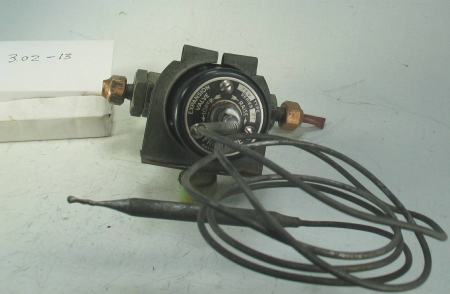Refrigerant Flow Controls – Commercial
An early mid 20th century, adjustable thermostatic expansion valve, housed in a 4 lb. solid cast brass body with galvinized overcoat and classic brown Bakelite casing; thermal power element and 4 ft. capillary tube; the TEF series, engineered for the new Freon 12 as well as SO2 applications, superseded the TS series, being more compact and better sealed against moisture; recommended for multiplexed applications popular in the period; Model TEV, Frigidaire, circa 1936. [Similar to ID# 206, but with higher range and mounting bracket]
Features:
Heavy steel mounting bracket with galvinized overcoat
Technical Significance:
Adapted for the new generation of non-noxious, hydrocarbon refrigerants, this early mid 20th century TX valve by Frigidaire was more compact and better protected from moisture than its earlier TS series [see ID# 185 & 186]. It was promoted by Frigdaire for multiplexed systems and would find wide spread application in a new generation of small, commercial refrigeration to be found in a new generation of food stores and confectioneries.
This artifact of history tells the many stories of technological diffusion and wide spread adoption of TX refrigerant flow control technology. After a brief flurry of excitement over the use of costly and delicate float operated devices, as a more efficient means of flow control, industry engineers would return to the automatic expansion valve in the early 30’s. But for many medium and larger applications the automatic expansion valve would give way to the more elegant and efficient thermostatic valve for use in a new generation of “dry evaporator” applications.
Industrial Significance:
Of special significance is the appearance of General Motors name on the valve, marking the period in which large manufactures, having built significant engineering and manufacturing know-how, as well as cash reserves would move into new fields. Horizontal integration would soon become a bus word in the industrial world.
Made in a wide range of capacities the TEV would mark a major, costly engineering commitment by Frigidaire to TX valve technology in the period, confident of its market potential.
These valve would see service well into the 1950’s attesting to their robust construction and field serviceability, with an operating life of 20 to 30 years and more.


